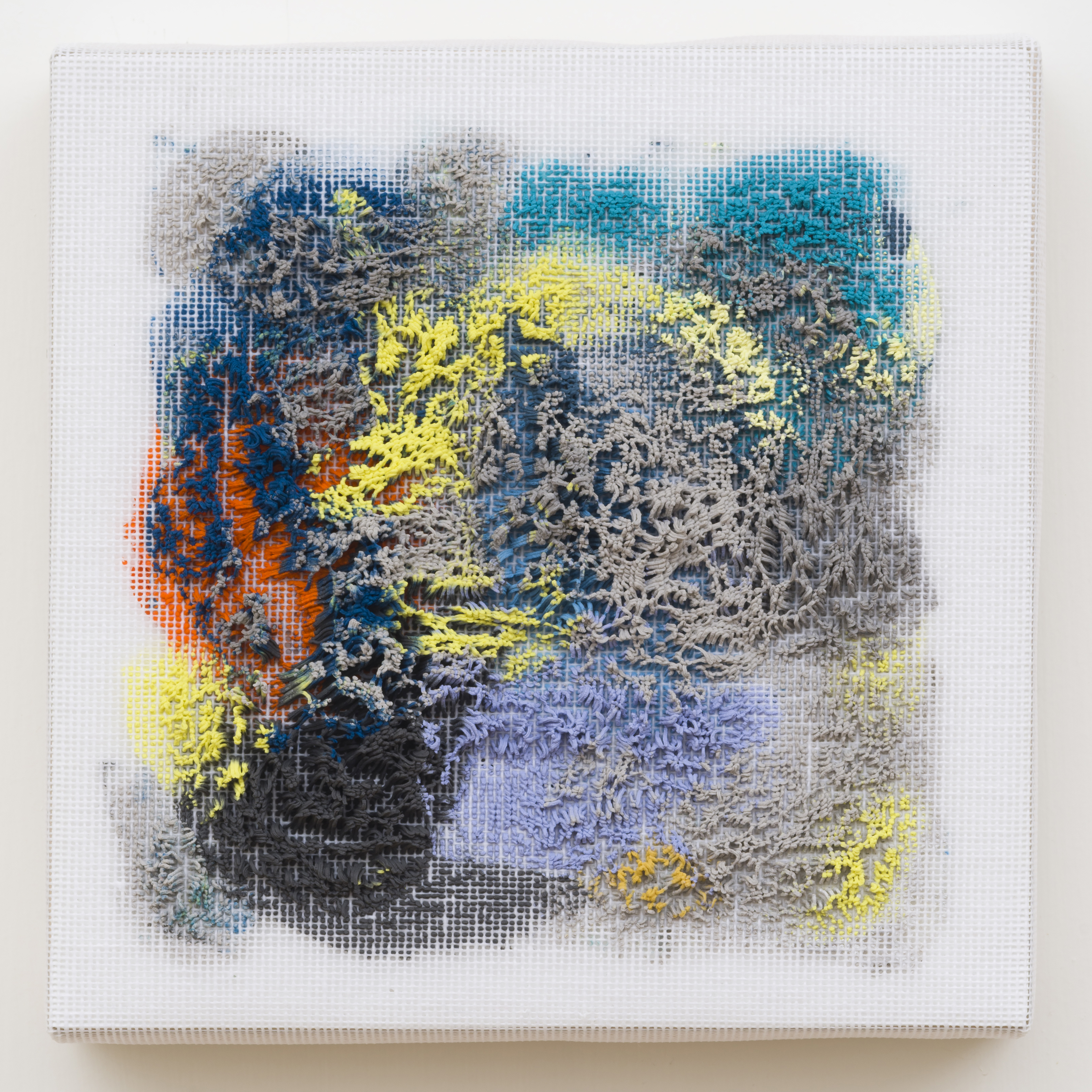
31 May Telluride Gallery: New Online Store, Update!
Telluride Gallery of Fine Art launched its online store on Monday, May 4, 2020, dedicating 10% of all sales between May 5 – June 5 to the Telluride Foundation’s robust COVID-19 Response Fund.
Created in response to COVID-19, Telluride Gallery’s online store seeks to highlight groups of artists, all of which are deeply affected by the health crisis. This unique opportunity allow collector to purchase smaller works by renowned artists at unprecedented prices. New works will be added to this initiative weekly.
Go here for more on the Foundation’s fund. Go here to order.
And please scroll way down past the artists originally featured for examples of work by artists recently added to the Telluride Gallery’s virtual store.

Brief Movement #22
No doubt, #19, this virulent variation on the theme of the coronavirus, is shaking up the world. All too many people are dying and critical resources in communities large and small are stretched to breaking. That said, in such times, a howl against the now and against the future is futile.
Better to focus on freedom.
A walk in the fresh mountain air.
Or a trip inside to a quiet place – that boundless world of the imagination. The interior landscape, where art happens.
“In Caleb Cain Marcus’s series titled ‘A Brief Pause After Death,’ the artist visually captures the space between moments, turf that pervades all things when we slow down and quiet the noise. Today, we are collectively realizing the foundations of our known experiences and realities no longer apply. That visceral understanding can lead to great discomfort – unless and until we hit ‘pause.’ Truth is a rare opportunity to let go and experience things just as they are lies in the moment between an inhale and an exhale. We find relief there. We find our creativity there too,” explained Ashley Hayward, co-owner, Telluride Gallery.
That quiet place has inspired all the ground-breaking shows at the Gallery.
And it clearly defines the world of fine art photographer Caleb Cain Martin.
Caleb Cain Marcus:
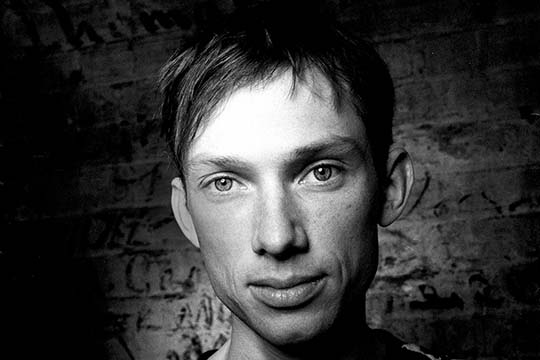
Increasingly abstract, Caleb Cain Marcus’ work has always had a dreamlike quality that transcends mere reportage to reveal something new about place and time. The artist enhances his photographs with layers of paint, creating an even deeper, more compelling image, the direct result of his belief that evocative colors deepen our understanding of the universe, internal and external.
Particularly, though not exclusively, in his latest body of work, Caleb has dismantled the building blocks of visual processing, eliminating perspective and scale and the narratives those variables suggest. In the end, he has effectively given physical, visible form to whatever is left that dissipates into thin air and the Original Source following death. The images then function like visual force fields: while grounded in the natural world, they capture and contain spiritual energy.
As a starting point for “A Brief Moment After Death,” Caleb took as his subject New York and California’s coastal landscapes, then expunged any clear references to geography. His ambitious goal: to depict the body’s release of energy back into the universe just after we die, when the heart stops, but science says consciousness continues to function if only for a few seconds.

Brief Movement #17
One critic described Caleb’s work this way:
“The markings seen in this series of images were supposedly random, but did not feel like it. Much like Anastasi’s drawings, Cain Marcus’ images echo automatic drawings attesting to the artist’s lack of control… which brings us back to the nature of death and life and the seemingly random influences of how and where they will touch all of us.”
Caleb’s photographs have been published in Orion, PDN, Conde Nast Traveler, Polka, Fisheye, The Scotsman, Time Lightbox, Smithsonian, Hyperallergic, National Geographic and Slate, among other outlets internationally.
Caleb Cain Marcus’ art is in the permanent collections of the Metropolitan Museum of Art, the Getty Museum, the Museum of Fine Arts Houston, the High Museum of Art and other notable venues.
Barbara Heinrich:
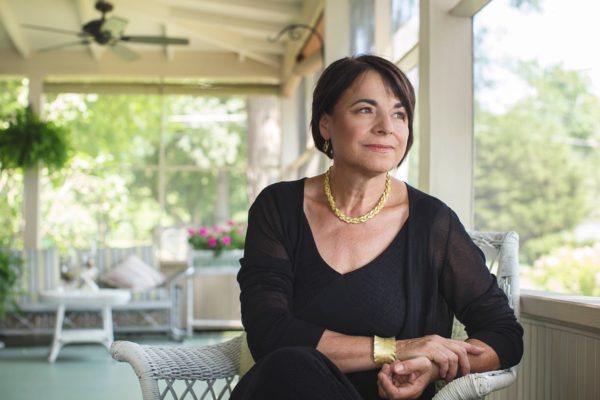
Internationally renowned jeweler Barbara Heinrich – now widely recognized for her textured surface treatments of gold like soft brushing, granulations and embossing – grew up on a farm in Heilbronn, Germany, the daughter of winemakers. And her designs reflect her roots. Her award-winning gold bling is clearly inspired by the natural world – but anchored in German precision engineering: the Milky Way, lotus flowers, aspen leaves, grass, dewdrops, are among the shapes that have informed her lines – and legions of collectors – over the years.
Barbara studied jewelry and hollowware design in Germany after completing a formal gold-smithing apprenticeship at Pestalozzi Kinderdorf. She went on to earn an MFA in the US at Rochester Institute. Since opening her studio in upstate New York in the 1980s, the metal artist has emerged as, well, a golden girl, racking up coveted awards for her signature designs.
Barbara Heinrich has also served as a juror at ACC conferences, given lectures and taught workshops. She is currently president of the American Jewelry Design Council, an active member of numerous professional jewelry organizations and widely regarded as a leader in the art-jewelry industry.
“My pieces are contemporary interpretations of botanical themes. I instill a delicate sense of proportion, form and color in each design to achieve a sense of timeless beauty. The understated look of my collection is achieved through matted gold surfaces and burnished edges, combined with employing of various ancient gold-smithing techniques,” stated the artist.“For me, jewelry is a delicate balance between hard geometric lines and flowing organic shapes. And we trusts creating beautiful things in gold never goes out of style.”
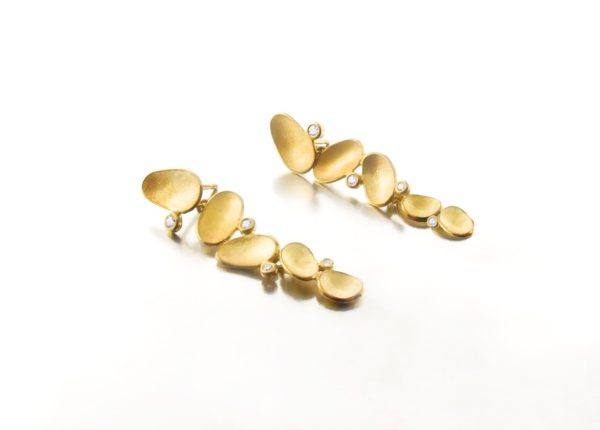
Caleb Cain Marcus and Barbara Heinrich are two of thefeatured artists at the Telluride Gallery’s brand new online store, created in response to COVID-19 and featuring original work for under $5,000. The store seeks to highlight groups of artists, all of whom are deeply affected by the health crisis.
Nelson Parrish:
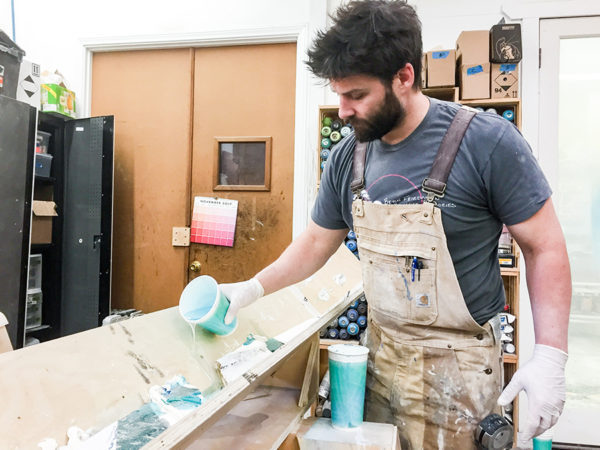
The term “Action Painting” is often used as a synonym for the work of a loose confederacy of artists known as the Abstract Expressionists, a lineage that became the dominant force in American painting by the end of the 1950’s. As a group, AbExers were not unified by much except for the fact that what drove them all – from Mark Rothko to Clyfford Still, Robert Motherwell and Jackson Pollack – was an unbridled sense of freedom of expression that marked post-WWII America.
However, the term “action painter” takes on a whole new, far less subtle meaning when applied to artist Nelson Parrish, who has lived his life in constant motion and has no plans to quit now, especially not since his career has gained serious momentum.
Now based in Southern California, Parrish grew up in Alaska. There he spent his youth careening down slopes, pedaling over ridge lines, swimming across lakes, hiking into the backcountry – and years later, practicing misogi, a punishing Shinto ritual which he once described as “a mental and spiritual challenges wrapped in a physical package.”
That description equally applies to Parrish’s art, generally speaking his “totems,” the artist’s term for works that are flashes of color – or how we see a world in motion – handcrafted of wood, aerospace aluminum and layered bio-resin, infused with splashes of vibrant color and racing stripes. The totems, really fusions of painting and sculpture, are very physical abstractions that capture and freeze many of the breakneck moments in the artist’s life when his perceptions of the world were (and are) naturally intensified.
“Nelson Parrish captures misogi in the illuminated space between the slices of his totems,” explained Ashley. “Those in-between spaces underline the spark of our limitless potential.”
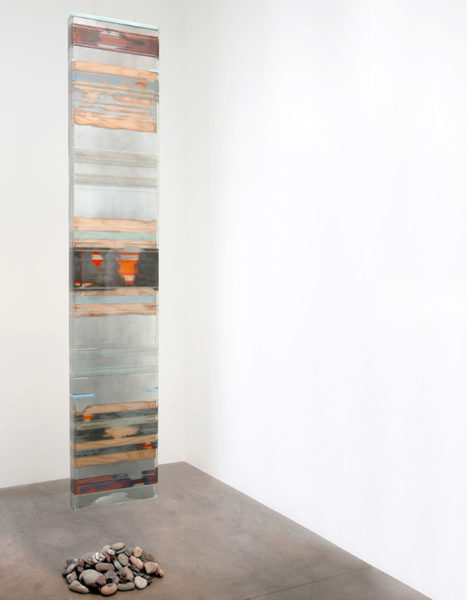
In the end, color and light and intense interaction with his surroundings bring focus and clarity to Parrish’s unique artistic expression, so that all of his art evokes the same sense of elation in his viewers he feels in motion when in the outside in the physical world – or inside in his studio.
“I studied color my whole life. I see it as the vernacular we use when traditional words fail. Color is a universal language, utilized for translating thoughts and experiences viscerally and immediately. I refine abstracted known forms – totems, flags, flitches and river teeth – to contain ideas, then I implement the action of painting and sculpting to make those ideas visible and tangible. My artifacts are created through this vocabulary.
“‘Of Light and Color’ are as much about Telluride, as they are for Telluride. They are the alchemy of those indescribable moments that make us stay, ‘The Light in the Canyon.’”
It could be said that Parrish’s sculpture-like forms encapsulate the pure joy of living fully in each and every moment, a great lesson for the Age of Corona. They are all about challenging himself – and us – in unexpected ways to push the envelope: physical, mental and emotional.
“Action Painting” writ large.
Petra Class:

Image courtesy JFK magazine.
In a recent interview, Petra Class defined her style as “elegant-funky,” words that apply equally to her fabulous jewelry.
“Creating jewelry is like writing music. On a creative day, it will be improvisational, while other times the elements need to be arranged and rearranged to form the right harmony or dissonance. I try to listen to the inner quality of each element to create a composition that does it justice,” Petra once told Artful Home.
The German-born, Bay Area–dwelling designer knew who she was to become from the get-go:
“I loved my mom’s jewelry box; my favorite page in the encyclopedia had images of Tutankhamen’s mask and jewels; my grandfather’s garden in summer was full of flowers to weave into necklaces,” Petra told JFK Magazine.
Petra Class is drawn to contrasts – see above, “elegant and funky” – the understated, yet seductive, quality of uncut stones in combination with gold and polished diamonds, shapes the artist tends to repeat in her “compositions.” One year, a signature necklace recapping Petra’s style was worn by so many women in Telluride it seemed as if the artist had created a secret order or sorority.
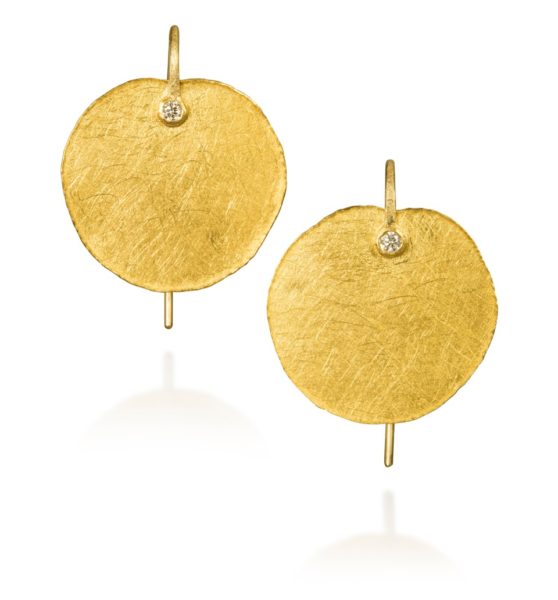
Petra’s education in metal arts began at Abitur, Johannes-Kepler-Gmnasium, at the University of Stuttgart. She then went on to pursue gold-smithing at Fachschule fuer Glas und Schmuck in Neugablonz, opening her first studio in Berlin in 1987 then, a few years later, establishing her current studio in San Francisco in 1991.
Petra Class’s work has been featured in solo exhibitions throughout the US, as well as many national and international group shows. At a recent Smithsonian Craft show, Petra received the Excellence in Jewelry Award. She has also been widely celebrated in books and magazines highlighting studio jewelers.
LéAna Clifton:

Born in Pretoria, South Africa, LéAna Clifton is now a Marfa-Texas based artist who has been working in mixed-media for over 12 years.
LéAna is drawn to large fields of color and contrasting line. For the past six years, she has focused, almost exclusively, on creating small- and large-scale abstract images of freight trains running through the far west Texas high-desert, capturing their visceral power and movement through color and contrasting lines.
Lé Ana was exposed to art and photography at a young age and, through that discipline, she discovered a portal through she could reimagine and remix the world on her own terms. The camera became her communicator – and her escape. As she progressed in her craft, LéAna’s images became less definable, more abstract and also more beautiful. Increasing visceral, her new pieces distill the key elements of her composition down to the real nitty-gritty: light, form, color, movement and time.

Clifton, Red Hots

Clifton, Aurora III

Clifton, Happy Hour
The goal? For her viewers to experience the excitement and dynamism of the moments the artist endeavors to capture.
Living in rural West Texas, the stark winter landscape was a downer for LéAna, however, she found escape in the colors of the trains passing through Marfa, which lightened and brightened her world. Those moments of exhale when the trains passed through provoked, as suggested above, LéAna’s most recent body of mixed-media work, pieces that unite her love of abstract, long-exposure photography – with no digital manipulation – with traditional hand techniques such as pencil and paint.
“I’ve always been inspired by the visceral nature of light in its own right. The various photography techniques I use have enabled me to play with light, hence with color and time. To stretch it, to distill it, to break it and redefine it. To use the camera as a tool for painting with light, in a manner. They blur the line between reality and a dream-state. A 4th dimension. The relationship between time and light is also integral to my work. My images capture more than an instant in time. My stills represent many ‘instants’ merged. And that tickles my brain a bit. I feel my art should do/be three primary things: 1. To delight, uplift and intrigue the viewer. (Tickle the viewer’s brain every time they look at it!); 2. Should be timeless; 3. Should be accessible to all, not just an elite few, hence my embracing of industrial and commercial media in most of my work,” LéAna explained.
Todd Pownell:
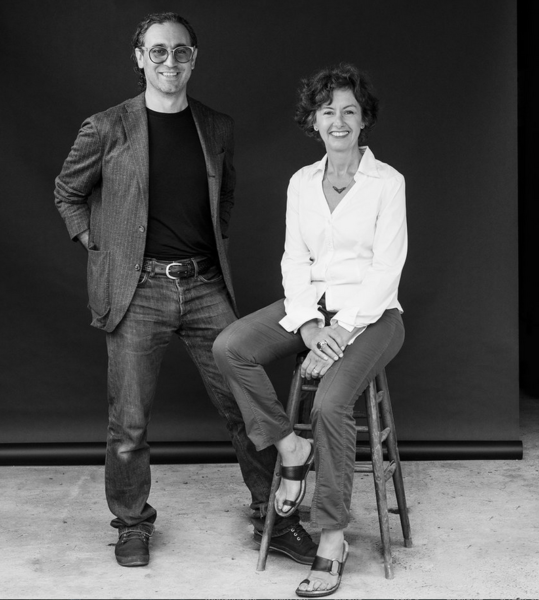
Based in Cleveland, Todd Pownell works in a variety of metals including gold, silver, palladium, and platinum. His unusual technique brings out the organic qualities of the elements, which are further enhanced by white and cognac diamonds set inverted or upside-down. Both that unique way of setting and his casting techniques give an edgy quality to Todd’s jewelry line. The added “icing”? The man is a member of Ethical Metalsmiths, jewelers for social and environmental responsibility.
“My exploration in the process of jewelry-making is with a deep respect for the innate properties of the material. The noble metals and gemstones display strong qualities of order and structure within their internal network… I like to think of my designs as evolving from an emotional state to an aesthetic experience and back again. Romanticism is a powerful influence. The interaction of dark and light metals mixed with fine gold and diamonds combine to evoke a strong sense of mystery and a sublime nature. Diamonds are bead-set upside-down onto the surface in pave or scattered across the piece. This reverse setting effectively captures and reflects light in a succession of broad flashes from the oblique angles creating a feeling of twilight. Visually the effect is similar to the display of a gathering storm in the night sky. Or one can be reminded of the low-angled light as it is cast across the vista into the gazing eye.”
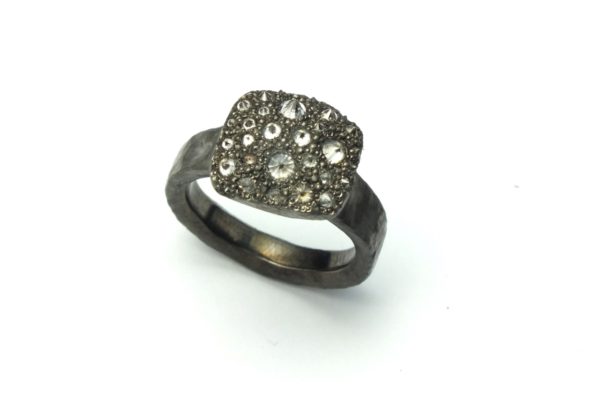 In 2008, Todd focused on developing his design jewelry line; “Tap by Todd Pownell,” that has since grown from a two- to a four-person workshop.
In 2008, Todd focused on developing his design jewelry line; “Tap by Todd Pownell,” that has since grown from a two- to a four-person workshop.
Over the years,Todd has taught and given numerous lectures and workshops focusing on topics such as stone-setting, fabrication and how to build a viable studio.
Todd Pownell is a Graduate Gemologist whose work has been featured in a variety of publications including the Lark Books series. He is a member, as mentioned above, of the ethical metalsmith’s jewelers for social and environmental responsibility, artists who support ethical mining in sourcing their materials. He is also member of the Society of North American Goldsmiths, Gemological Institute of America and the American Craft Council.
Recent additions to the Gallery’s online store include Dan McCleary, Kristin Beinner James, Maggie Taylor, Michael Reafsnyder, Elizabeth Garvin, Emanuela Duca, and Laura Wood.

Dan McCleary, The Rehearsal.

Michael Reafsnyder, Sweet Flow, acrylic on linen.

Laura Wood

Kristin Beinner James

Emanuela Duca, Burst


Sorry, the comment form is closed at this time.